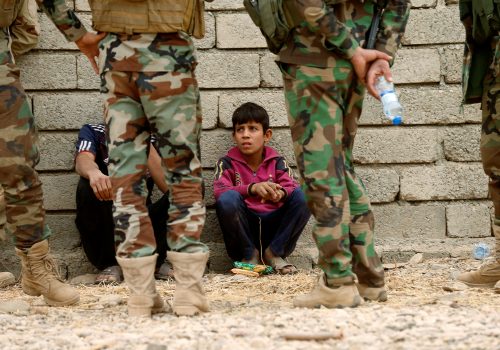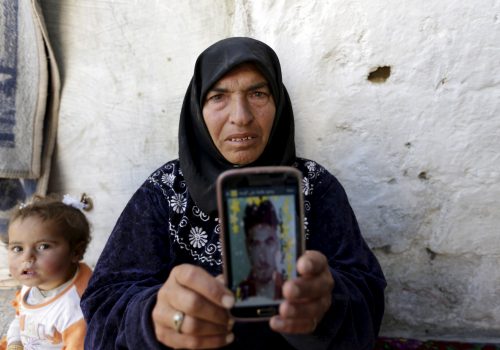ISIS has a new leader. It’s important to understand their operational capacity.
Over the last two months, news about the Islamic State of Iraq and al-Sham (ISIS) dominated international media headlines. On February 3, US special forces eliminated ISIS leader Abu Ibrahim al-Qurashi in Syria, two weeks after the group’s most significant attack on the Syrian Democratic Forces (SDF)-run al-Sina’a prison in al-Hasakah province. On March 10, the group named its new leader, Abu Hassan al-Hashimi al-Qurayshi, in a bid to ensure its continuity and avoid potential fragmentation.
While discussions over the identity of the new leader and power succession within ISIS offer a valuable insight into the group’s organizational structure, the attack on al-Sina’a prison and other similar attacks reflect its operational capacity and the future threat it will pose to the region. However, despite their size, these attacks are largely doomed to end in favor of ISIS’s enemies, making one wonder why the group waged them in the first place.
Through al-nikaya fighting, a well-established warfare tactic in the jihadi Salafi strategic playbook, which ISIS has employed since late 2016 in Syria and Iraq, ISIS seeks to replenish its depleted manpower and show its continued relevance.
It’s al-Nikaya time
With a car bomb and three hundred fighters, ISIS broke into SDF-run al-Sina’a prison, which houses between 3,500 and five thousand ISIS inmates, killed its guards, freed an unknown number of its fighters, and established control over its facilities. Ten days of heavy clashes ensued between ISIS attackers, who were also joined by inmates, and SDF forces supported by the US-led coalition. The significance of the recent attack cannot be overstated, as it sends an intense signal regarding ISIS’s operational capacity as well as the SDF’s limited ability to contain the threat. Moreover, the attack reflects ISIS’s awareness of the constantly changing realities and its high adaptability to its loss of territorial control.
There are two types of jihad in the jihadi world that are determined by the reality on the ground and the jihadi groups’ capabilities: jihad al-tamkin, or jihad of empowerment, and jihad al-nikaya, or jihad of vexation and exhaustion. Under the former, the group seeks to control and rule over a geographical area and impose its interpretation of Islam. Under the latter, the goal is to inflict harm on the enemy’s interests with hit and run tactics suited to its lack of territory and manpower. Al-nikaya includes ambushes, suicide bombings, attacking prisons, and assassinations of leading enemy figures and collaborators. In 2014, when ISIS announced the establishment of its so-called caliphate, which stretched between eastern Syria and western Iraq, it shifted from jihad al-nikaya to jihad al-tamkin. However, with its loss of territories and assets, which started in 2016, the group has gradually but systematically returned to jihad al-nikaya.
While al-Qaeda has been largely loyal to al-nikaya—as evidenced by the September 11, 2001 terrorist attacks as well as the 2004 Madrid and 2005 London bombings—claiming that it wasn’t yet time to announce the establishment of the caliphate, ISIS hasn’t only alternated between the two based on the reality on the ground but also merged during its heyday between 2010 and 2014, as noted by scholar Hassan Abu Hannyia.
No jihad without jihadis
ISIS’s attempt to free its fighters from prisons isn’t new and reflects the group’s increased need for manpower. In November 2021, the SDF and US-led international coalition thwarted a plot by a suspected ISIS cell in eastern Deir ez-Zor province, which was planning to attack the same prison. The group’s manpower has significantly diminished since its territorial defeat in 2019. Thousands of attacks in Syria and Iraq has worn ISIS down, as well as its enemies’ ability to neutralize or capture thousands of its fighters.
According to Jihad Analytics, a consultancy company on global and cyber jihad, ISIS claimed 1,764 and 3,144 attacks in Syria and Iraq, respectively, between March 2019 and January 2022. While a 2019 United Nations (UN) report estimated that ISIS had up to eighteen thousand fighters, including three thousand foreign fighters operating in Syria and Iraq, a recent 2022 UN assessment claims that the group has only retained between six thousand and ten thousand, which means that ISIS has lost almost half of its fighters via death or capture. Today, the SDF still holds ten thousand ISIS fighters in its prisons, which is seen as a valuable pool for the group’s drained rank and file. This was reflected by two speeches made by ISIS spokesman, Abu Hamza al-Qurashi, in June and October 2021, in which he explicitly called his supporters to free ISIS inmates from SDF prisons.
The international war against ISIS has deprived the group of the territories it once controlled and clamped down on regional borders, closing the pipeline of foreign fighters coming into Syria, most of whom are known for their ideological intransigence and fighting experiences. This reality has pushed the group to rely more on local fighters, who don’t necessarily believe in its ideology but, rather, were pushed by local grievances generated by social inequality, political exclusion, and a lack of better options.
According to Omar Abu Layla, CEO of Deirezzor 24, an independent news platform with local researchers on the ground, “Anti-SDF sentiments have been increasingly growing on a daily basis. Since the Kurdish-dominated forces have ruled Northeast Syria in 2016, they haven’t changed their discriminatory policies vis-à-vis the Arab population.” Abu Layla’s views were echoed by a local source who told me that “Life is unbearable under SDF. They speak about how bad time under ISIS was. But life is worse now. We didn’t have to queue for hours to get bread. We are Arabs and it’s suffocating to see our women being humiliated by the SDF in the camps,” referring to the dire situation that thousands of women endure in al-Hol camp. Pushed by these anti-SDF sentiments and the fear of ISIS violence, and pulled by ISIS’s extremist interpretation of Islam, some locals have become more susceptible to recruitment.
The caliph is dead, but…
The war on terror has shaped US politics and informed its engagement in the Middle East since 9/11. Moreover, while the killing of ISIS leaders represents a symbolic win for the international community and boosts American presidents’ popularity at home, there is little to suggest that it’s the most effective tool to eliminate the group’s threat.
Many prominent ISIS and al-Qaeda leaders have been killed, yet the groups remain a menace in the Middle East and beyond. For jihadists, it’s natural that leaders will eventually die, but jihad shall continue generationally. In his 2016 speech, former ISIS spokesman Abu Muhamad Adnani posed a question to ISIS enemies, particularly the United States: “Do you think that you have won the war against the Islamic State when you killed Abu Musab al-Zarqawi or Bin Laden or…Do you think that you will win the war if you kill Abu Omar al-Shishani or Abu Bakr Al-Baghdadi…?
Since then, two ISIS leaders have been neutralized—Abu Bakr al-Baghdadi and Qurashi—and the group has lost its haven in Syria and Iraq. The prospect of reestablishing its “caliphate” is still far-fetched, yet, the group still retains its sleeper cells and lone wolves, who can disrupt stability and prove relevance.
Following its attacks on al-Sina’a prison, ISIS’s Naba’ weekly magazine claimed that it would refrain from announcing the number of inmates it freed. On another occasion, the group claimed to have freed eight hundred of its fighters while the SDF spokesman denied the escape of any senior ISIS members. However, recent reports suggest that more than two hundred ISIS inmates have been free, including senior Iraqi members. All these claims are difficult to verify, but the chaotic ten days that followed the attacks likely offered ISIS inmates their most convenient chance to escape since the demise of their “caliphate” in 2019. Additionally, had there been no escapees, why would the SDF demolish civilian houses in the neighborhood searching for ISIS inmates on January 29? Those who fled will likely rejoin the group, replenish its manpower, and continue waging its jihad of al-nikaya until a different reality unfolds.
Former ISIS spokesman Adnani claimed that defeat means losing the will and desire to fight. If the international community is serious about defeating ISIS, it must eliminate the factors and circumstances that have allowed the terrorist group to thrive. However, if it continues to bury its head in the sand by focusing only on a security-oriented approach to combating ISIS, leaving the Arab majority’s grievances unresolved and refusing to repatriate its nationals, the ISIS threat won’t go away anytime soon.
Orwa Ajjoub is a senior analyst at COAR global focusing on jihadism and Syria. He previously worked as an affiliated researcher at the Center for Middle Eastern Studies at Lund University. Follow him on Twitter: @OAjjoub.
Further reading
Thu, Aug 19, 2021
ISIS is defeated. What becomes of the ‘Cubs of the Caliphate’ in Iraq?
MENASource By
In the aftermath of sanctions, three wars, and continued violence, Iraq’s infrastructure and established child services networks remain debilitated. The reintegration of child soldiers is an extensive and long-term project that demands more than Iraqi institutions can give.
Thu, Feb 10, 2022
A perpetrator of Syrian crimes against humanity went free in France. Here’s why it shouldn’t happen again
MENASource By Michel Duclos
If the scope for changing the course of events in Syria is limited, it’s honorable to take a stand against the abominable crimes of the Bashar al-Assad regime. It would be a great pity for France to be seen as a safe haven for Assad’s accomplices.
Tue, Oct 6, 2020
I survived Assad’s torture—here’s why I’m a proud advocate of the Caesar Act
MENASource By
The Caesar Act is not the solution, but an important tool that the US and the international community must use alongside others to end the killing in my homeland.
Image: Iraqi security forces display vehicles, weapons and ammunition they confiscated from the Sunni militant group 'Islamic State in Iraq and the Levant' (ISIL), in Samarra, June 6, 2014. Iraqi helicopters bombed the city of Samarra after insurgents overran parts of it early on Thursday, bringing them within striking distance of a Shi'ite shrine the destruction of which in a 2006 attack unleashed a bitter sectarian war. The offensive is part of an escalating conflict between Iraq's Shi'ite Muslim-led government and Sunni Islamist militants who have been regaining momentum in the past year, particularly in the west of the country bordering Syria. REUTERS/Stringer (IRAQ - Tags: CIVIL UNREST CONFLICT MILITARY CRIME LAW POLITICS)


